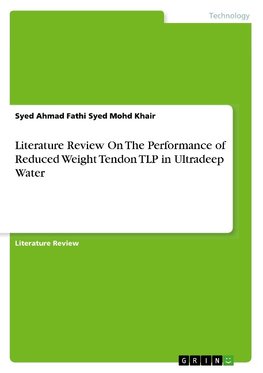
-
 Anglický jazyk
Anglický jazyk
Literature Review On The Performance of Reduced Weight Tendon TLP in Ultradeep Water
Autor: Syed Ahmad Fathi Syed Mohd Khair
Literature Review from the year 2014 in the subject Engineering - Naval Engineering, Ocean Engineering, grade: 3, , language: English, abstract: The fast growing offshore industry has come up with advanced technology that makes it possible to produce oil... Viac o knihe
Na objednávku, dodanie 2-4 týždne
12.96 €
bežná cena: 14.40 €
O knihe
Literature Review from the year 2014 in the subject Engineering - Naval Engineering, Ocean Engineering, grade: 3, , language: English, abstract: The fast growing offshore industry has come up with advanced technology that makes it possible to produce oil and gas on deeper offshore sites. One of the interests now is to look for a structure and systems that are reliable and cost effective for ultra deep water operation. Tension leg platform (TLP) concept is currently been viewed for this ultra deepwater operation. TLP differ from other type of floating platform in a sense that the hull buoyancy exceed its weight, the hull is vertically moored at a draft below the displacement thus creating constant tension in the mooring line. The problem for the development of TLP beyond 1500 meters water depth is the material for the tendon. Conventional tendon made by steel is too heavy and proven to be unpractical in ultra deep water. New material is needed, that is lightweight and stiffer, and this material needs to meet the structural performance characteristic for practical development. This research is intended to demonstrate the performance of reduced weight tendons in ultra-deep water. The effect of weight reduction on motion response of the TLPs in regular and irregular waves and the performance differences between conventional tendons and reduced weight tendons in term of motion response also will be investigated. Based on the review it is known and widely accepted that numerical analysis is the most practical and economical way to analyze the structure, but because of the simplification and assumption of the numerical calculation a validation is needed. The numerical analysis will be done using industrial accepted software, ANSYS AQWA. For the purpose of validation, model test is proposed to be done in the test basin, but due to very limited water depth in the test basin, truncation method will be used instead of common traditional test. This method also known as hybrid method that uses numerical calculation to predict the cut off portion of the tether lines and using physical model test in the upper portion.
- Vydavateľstvo: GRIN Verlag
- Rok vydania: 2017
- Formát: Paperback
- Rozmer: 210 x 148 mm
- Jazyk: Anglický jazyk
- ISBN: 9783668560086











 Nemecký jazyk
Nemecký jazyk 